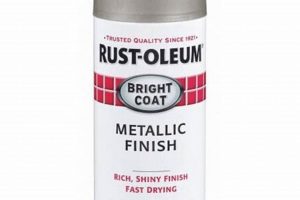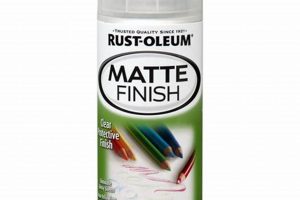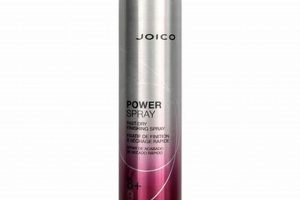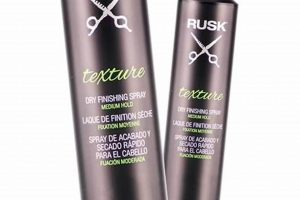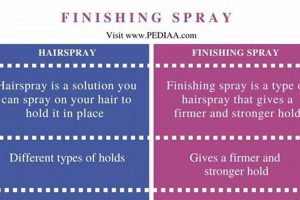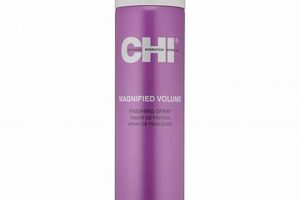A non-reflective coating applied via aerosol, it results in a surface that diffuses light, eliminating gloss or shine. This type of coating is often utilized on objects where glare is undesirable, or where a subtle, understated appearance is preferred. Examples include automotive trim, artistic sculptures, and functional tools.
The advantage of this type of coating lies in its ability to minimize imperfections and provide a uniform appearance. Its use dates back to the early applications of aerosol technology in the mid-20th century, where it provided an alternative to labor-intensive hand-applied coatings. Its continuing popularity stems from its ease of application, durability, and aesthetic appeal.
The following sections will delve into specific techniques for application, appropriate surface preparation, considerations for different materials, and the various applications where a lack of reflectivity is highly valued, enhancing both functionality and visual appeal.
Application Techniques for a Non-Reflective Coating
Achieving a consistent, durable, and aesthetically pleasing non-reflective coating requires careful attention to detail during the application process. The following tips outline best practices for optimal results.
Tip 1: Surface Preparation is Paramount: Ensure the substrate is clean, dry, and free from contaminants like grease, rust, or loose particles. Sanding the surface to create a “key” allows the coating to adhere properly, preventing peeling or chipping.
Tip 2: Priming Enhances Adhesion and Uniformity: Applying a primer coat, especially on porous or dissimilar materials, creates a uniform base for the color coat. This improves adhesion and ensures consistent color saturation across the entire surface.
Tip 3: Apply Thin, Even Coats: Multiple thin coats are superior to a single thick coat. This technique minimizes the risk of runs, drips, and pooling, resulting in a smoother, more even coating. Allow each coat to dry thoroughly before applying the next.
Tip 4: Maintain Proper Spraying Distance: Holding the can at the recommended distance, typically 6-10 inches, is critical. Spraying too close can lead to excessive build-up and runs, while spraying too far can result in a textured, uneven finish due to the paint partially drying before contacting the surface.
Tip 5: Use a Consistent Spraying Motion: Employ a smooth, overlapping motion, moving the can parallel to the surface. Avoid arcing or stopping mid-stroke, as this can cause uneven application and inconsistent coverage.
Tip 6: Control Environmental Factors: Ideal application conditions involve moderate temperatures (65-80F) and low humidity. Avoid spraying in direct sunlight or windy conditions, as these can negatively impact drying time and coating quality.
Tip 7: Invert and Purge the Nozzle After Each Use: To prevent clogging and ensure consistent spray patterns in future applications, invert the can and spray until only propellant is released. This clears the nozzle of residual paint.
Adhering to these techniques will yield a superior, long-lasting non-reflective coating. These methods improve the aesthetic result and ensure the coating protects the underlying material effectively.
The subsequent sections will elaborate on specific materials and applications, demonstrating the versatility and utility of these techniques in various contexts.
1. Durability
Durability represents a critical attribute of a non-reflective coating, dictating its lifespan and resistance to environmental stressors. The longevity of the finish directly impacts its protective capabilities and aesthetic appeal over time. Understanding the factors that contribute to its durability is therefore essential for successful application and maintenance.
- UV Resistance
Exposure to ultraviolet radiation can degrade the binders within the coating, leading to fading, chalking, and a reduction in structural integrity. Formulations with enhanced UV inhibitors are crucial for applications exposed to prolonged sunlight. Automotive applications, outdoor sculptures, and architectural elements require coatings specifically designed to resist UV degradation to maintain their appearance and protective qualities.
- Abrasion Resistance
The ability to withstand physical wear and tear, such as scratching and scuffing, is vital for maintaining the finish’s integrity. Coatings with higher solid content and cross-linking agents exhibit improved abrasion resistance. This is particularly important for surfaces subject to frequent contact, such as furniture, tools, and vehicle interiors.
- Chemical Resistance
Exposure to chemicals, including cleaning agents, solvents, and pollutants, can compromise the coating’s integrity, leading to discoloration, softening, or even dissolution. The chemical resistance of a non-reflective coating is determined by its formulation and the nature of the chemical exposure. Applications in industrial environments or those involving frequent cleaning require coatings with specific chemical resistance properties.
- Adhesion Strength
The strength of the bond between the coating and the substrate is a fundamental factor in its overall durability. Proper surface preparation, including cleaning, sanding, and priming, is essential for maximizing adhesion. Poor adhesion leads to premature peeling, chipping, and coating failure, regardless of the coating’s other attributes. This is applicable across all applications, highlighting the importance of meticulous preparation before applying any coating.
The facets described above illustrate the complexities involved in achieving a durable non-reflective coating. Each attribute contributes to the overall performance and longevity of the finish, highlighting the need for careful selection of the appropriate formula and diligent application techniques. The investment in high-quality materials and meticulous application practices will yield significant returns in terms of extended lifespan, reduced maintenance, and sustained aesthetic appeal. These considerations are paramount regardless of the scale or complexity of the coating project.
2. Adhesion
Adhesion is a critical factor in the performance of a non-reflective coating. It directly determines the coating’s ability to resist separation from the substrate, influencing its longevity and protective capabilities. Poor adhesion inevitably leads to premature failure, manifesting as peeling, chipping, or blistering, rendering the coating ineffective and aesthetically unappealing. Proper adhesion is not merely desirable; it is a prerequisite for a functional and durable non-reflective coating. Real-world examples of adhesion failure include automotive paint peeling from improperly prepared metal surfaces and protective coatings detaching from infrastructure components due to inadequate bonding. These failures underscore the practical significance of understanding and optimizing adhesion in any coating application.
The achievement of adequate adhesion involves a multifaceted approach, beginning with meticulous surface preparation. Contaminants such as grease, oil, rust, and loose particles must be thoroughly removed to ensure intimate contact between the coating and the substrate. Mechanical abrasion, through sanding or media blasting, increases the surface area and creates a profile that enhances mechanical interlocking. Chemical treatments, such as etching or conversion coating, can further modify the surface to promote chemical bonding. Primers act as an intermediary layer, bridging the gap between dissimilar materials and providing a uniform surface for the non-reflective topcoat. The selection of an appropriate primer is critical for maximizing adhesion, particularly when dealing with challenging substrates such as plastics or non-ferrous metals. These techniques, employed individually or in combination, collectively contribute to the establishment of a strong and durable adhesive bond.
In summary, the success of any non-reflective coating application hinges on the establishment of strong and lasting adhesion. Proper surface preparation, the use of appropriate primers, and careful selection of coating materials are essential elements in achieving this objective. While challenges may arise due to substrate characteristics or environmental conditions, a thorough understanding of the principles of adhesion and the implementation of best practices will significantly enhance the performance and longevity of the coating, ensuring its continued functionality and aesthetic appeal.
3. Uniformity
Uniformity, in the context of a non-reflective coating, refers to the consistency of the coating’s thickness, texture, and color across the entire treated surface. It is a primary determinant of the final aesthetic appearance and directly impacts the coating’s ability to diffuse light effectively, eliminating unwanted glare and reflections. The absence of uniformity can manifest as visible inconsistencies, detracting from the visual appeal and potentially compromising the coating’s protective functions.
- Thickness Consistency
Variations in the coating’s thickness can lead to uneven light diffusion, resulting in visible patches or streaks. Areas with thicker coatings may appear darker or exhibit a slightly different texture compared to thinner areas. This inconsistency is particularly noticeable under direct lighting conditions and can compromise the intended aesthetic effect. Examples include unevenly coated automotive parts, where variations in thickness disrupt the smooth, non-reflective surface.
- Texture Homogeneity
A consistent surface texture is essential for achieving uniform light diffusion. Variations in texture, such as rough patches or areas with excessive orange peel, can scatter light unevenly, creating visible imperfections. This is especially critical in applications where a smooth, flawless appearance is desired, such as in high-end consumer electronics or architectural finishes. The coating must exhibit a consistent micro-texture across the entire surface to minimize unwanted specular reflections.
- Color Saturation
Consistent color saturation is paramount for maintaining a uniform appearance. Variations in color, even subtle ones, can be readily apparent, particularly on large, flat surfaces. Factors such as inconsistent spray technique, inadequate mixing of the coating, or variations in substrate color can contribute to color inconsistencies. Applications requiring precise color matching, such as in product branding or artistic reproductions, demand meticulous control over color saturation to ensure a uniform and visually appealing result.
- Absence of Defects
The presence of defects, such as pinholes, bubbles, or inclusions, disrupts the uniformity of the coating and can compromise its integrity. These defects scatter light randomly, creating visible imperfections and potentially reducing the coating’s protective properties. Careful application techniques, proper surface preparation, and the use of high-quality materials are essential for minimizing the occurrence of these defects and maintaining the overall uniformity of the finish. Examples include applications in aerospace or medical devices, where even minor defects can have significant consequences.
The pursuit of uniformity in a non-reflective coating is not merely an aesthetic concern; it is a critical factor in ensuring optimal performance and visual appeal. By meticulously controlling the application process, utilizing high-quality materials, and paying close attention to detail, a consistent and visually pleasing coating can be achieved. The considerations noted above highlight the multifaceted nature of uniformity, emphasizing the importance of a holistic approach to coating application.
4. Surface Preparation
Surface preparation constitutes a foundational element in achieving a successful non-reflective coating. The correlation between inadequate surface preparation and coating failure is direct and significant. Contaminants residing on the substrate, such as grease, rust, or loose paint, impede the formation of a strong adhesive bond between the coating and the material. This compromised adhesion leads to premature peeling, chipping, or blistering of the coating, negating its intended functionality and aesthetic value. For instance, if a metal surface is not properly cleaned and de-rusted before application, the non-reflective coating will inevitably fail, exposing the underlying metal to further corrosion. Thus, surface preparation is not merely a preliminary step but an integral component directly impacting the coating’s performance and longevity.
The specific methods employed for surface preparation vary depending on the substrate material and the nature of the contaminants present. For metals, degreasing, abrasive blasting, and chemical etching are common techniques used to create a clean and receptive surface. Wood surfaces may require sanding to remove imperfections and provide a key for the coating to adhere to. Plastics often necessitate cleaning with specialized solvents to remove mold release agents or surface oils. The selection of appropriate surface preparation methods is crucial, as improper techniques can damage the substrate or leave residual contaminants that compromise adhesion. For example, using an inappropriate abrasive on a soft plastic surface could create deep scratches that are visible through the coating. The practical significance of this understanding lies in the prevention of costly rework and the assurance of a durable, aesthetically pleasing finish.
In conclusion, surface preparation is inextricably linked to the success of a non-reflective coating. The effort invested in meticulous surface preparation yields substantial returns in the form of enhanced adhesion, increased durability, and improved aesthetic appeal. While challenges may arise from complex substrates or persistent contaminants, a thorough understanding of the principles of surface preparation and the implementation of appropriate techniques will significantly mitigate the risk of coating failure, ensuring the coating fulfills its intended function and maintains its visual integrity over time.
5. Application Technique
The achievement of a desirable non-reflective coating is intrinsically linked to the application technique employed. The manner in which the coating is applied directly influences the uniformity, thickness, and overall quality of the final finish. Improper application can lead to a range of undesirable outcomes, including uneven coverage, runs, drips, and a compromised aesthetic appearance. Consider, for instance, the application of a non-reflective coating to an automotive dashboard. If the spraying technique is inconsistent, resulting in varying thicknesses across the surface, the final product will exhibit noticeable variations in light absorption, undermining the desired matte appearance and potentially creating distracting reflections. Thus, application technique functions as a critical determinant of the success or failure of a non-reflective coating project.
Specific application techniques are particularly relevant to achieving the intended properties. Maintaining a consistent spraying distance, typically between 6 and 10 inches, is crucial for ensuring even coverage and minimizing the risk of runs. Employing a smooth, overlapping motion with the spray can helps to avoid streaks and uneven textures. The use of multiple thin coats, rather than a single thick coat, allows for better control over the final thickness and reduces the likelihood of trapping air bubbles or solvent within the coating. Furthermore, factors such as ambient temperature and humidity can significantly impact the drying and curing process. High humidity can impede the evaporation of solvents, leading to a prolonged drying time and potentially affecting the coating’s adhesion and durability. Therefore, understanding and controlling these environmental variables is essential for optimizing the application technique.
In summary, the application technique represents a critical component in the realization of a successful non-reflective coating. Its significance extends beyond mere aesthetics, influencing the durability, functionality, and overall performance of the coating. While challenges may arise from variations in substrate materials, environmental conditions, or applicator skill, a thorough understanding of best practices and a meticulous approach to the application process will significantly enhance the likelihood of achieving the desired non-reflective finish. The value of this understanding lies in the prevention of costly rework, the assurance of consistent quality, and the maximization of the coating’s protective and aesthetic properties.
6. Light Diffusion
The defining characteristic of a non-reflective coating lies in its capacity to diffuse light. Light diffusion refers to the scattering of incident light rays in multiple directions, rather than reflecting them in a specular (mirror-like) manner. This phenomenon results in a surface devoid of glare and highlights, presenting a soft, uniform appearance. A non-reflective coating achieves this effect through its micro-rough surface texture, which disrupts the path of incoming light rays, causing them to scatter. The absence of specular reflection is paramount in applications where visual clarity or aesthetic subtlety is desired. For example, in photography and videography, a backdrop coated with such a finish prevents unwanted reflections that could distort the image or distract the viewer. The effectiveness of a non-reflective coating is directly proportional to its ability to maximize light diffusion and minimize specular reflection.
The practical significance of light diffusion extends to a wide range of applications. In the automotive industry, interior components often receive a non-reflective treatment to reduce glare on the windshield, improving driver visibility and safety. In architectural design, matte finishes are employed on walls and ceilings to create a more comfortable and visually appealing environment by minimizing harsh reflections from artificial lighting. Furthermore, in the manufacturing of electronic displays, non-reflective coatings are applied to screens to enhance readability in brightly lit environments. These examples underscore the versatility and importance of light diffusion in various sectors, demonstrating how the manipulation of light reflection can significantly enhance both functionality and aesthetic appeal. The consistency of light diffusion is also critical, preventing uneven patches or distracting highlights.
In summary, light diffusion is the core principle underpinning the function of a non-reflective coating. Its ability to scatter light rays, eliminating glare and specular reflections, is fundamental to its effectiveness in numerous applications. Achieving optimal light diffusion necessitates careful attention to surface preparation, coating formulation, and application technique. Challenges may arise in maintaining consistent diffusion across large or complex surfaces, but a thorough understanding of the underlying principles and the implementation of best practices will yield significant benefits in terms of visual clarity, aesthetic quality, and overall performance. The proper application of these coatings improves visual experiences in diverse areas.
Frequently Asked Questions about Matte Spray Paint Finish
This section addresses common inquiries regarding the application, properties, and usage of a non-reflective aerosol coating.
Question 1: Is surface preparation truly necessary before applying this type of coating?
Yes, thorough surface preparation is non-negotiable. The presence of any contaminants, such as grease, rust, or loose particles, will compromise the adhesion of the coating, leading to premature failure. Proper preparation is fundamental for a durable and aesthetically pleasing result.
Question 2: What are the primary advantages of using a matte finish compared to a glossy finish?
The primary advantage is the elimination of glare and specular reflections. This is crucial in applications where visual clarity is paramount, such as instrument panels, photographic backdrops, and architectural interiors. A non-reflective coating also tends to minimize the visibility of surface imperfections.
Question 3: Can this type of coating be applied to all surfaces?
While versatile, this type of coating is not universally applicable. The suitability of the coating depends on the substrate material and the intended use. Certain plastics may require specialized primers to ensure adequate adhesion. Always consult the manufacturer’s recommendations for compatibility.
Question 4: How many coats are recommended for optimal results?
Multiple thin coats are generally preferable to a single thick coat. This technique minimizes the risk of runs, drips, and solvent entrapment. Two to three thin coats are typically sufficient to achieve full coverage and a uniform appearance.
Question 5: What environmental conditions are most conducive to applying this type of coating?
Ideal conditions involve moderate temperatures (65-80F) and low humidity. Avoid spraying in direct sunlight or windy conditions, as these can negatively impact drying time and the uniformity of the finish.
Question 6: How can the nozzle be prevented from clogging?
Invert the can and spray until only propellant is released after each use. This clears the nozzle of residual coating material, preventing clogs and ensuring consistent spray patterns in future applications. Proper storage in a cool, dry place is also essential.
In summary, a successful application relies on diligent surface preparation, appropriate material selection, proper application techniques, and an understanding of environmental factors. Ignoring these aspects will inevitably lead to unsatisfactory results.
The subsequent sections will address advanced techniques and specialized applications, expanding on the fundamental principles outlined here.
Conclusion
The preceding sections have provided a comprehensive examination of the attributes and application of matte spray paint finish. Surface preparation, application technique, and environmental control are critical factors. Furthermore, the principles of adhesion, durability, and light diffusion dictate the effectiveness and longevity of any coating project employing it. A deficient understanding or implementation of these principles invariably leads to compromised results, undermining the investment in materials and effort.
Therefore, a rigorous approach to each stage of the process, from initial surface assessment to final application, is paramount. Only through such diligence can the full potential of matte spray paint finish be realized, ensuring both aesthetic satisfaction and long-term functional integrity. Further research and adherence to best practices remain essential for continued advancement in its application across diverse industries.


